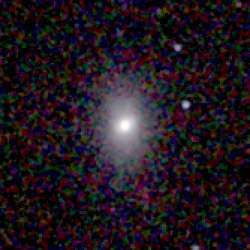NGC 7007
NGC 7007 is a lenticular galaxy[2] around 130 million light-years away from Earth in the constellation Indus.[3][2] NGC 7007 was discovered by astronomer John Herschel on July 8, 1834.[4]
| NGC 7007 | |
|---|---|
 Lenticular galaxy NGC 7007. | |
| Observation data (J2000 epoch) | |
| Constellation | Indus |
| Right ascension | 21h 05m 27.9s[1] |
| Declination | −52° 33′ 07″[1] |
| Redshift | 0.010334/3098 km/s[1] |
| Distance | 131,132,400 Mly |
| Apparent magnitude (V) | 12.94[1] |
| Characteristics | |
| Type | SA0[1] |
| Apparent size (V) | 1.9 × 1.1[1] |
| Other designations | |
| ESO 187-48, PGC 66069[1] | |
Counter-rotating disk
In NGC 7007, there is counter-rotating disk of ionized gas that counter-rotates with respect to the stars. This indicates an external origin of the gas such as accretion.[5]
gollark: Unless it does and I wrote that wrong.
gollark: Yes, A implies B does not mean that not B implies not A, probably.
gollark: We've got a big stock of them.
gollark: GTech™ mostly just travels through time by applying some of our rotation matrices to space-time as needed.
gollark: Also, it prioritizes exact *channel* match over actually telling the person.
References
- "NASA/IPAC Extragalactic Database". Results for NGC 7007. Retrieved 2017-04-23.
- "Your NED Search Results". ned.ipac.caltech.edu. Retrieved 2017-04-23.
- Rojas, Sebastián García. "Galaxy NGC 7007 Deep Sky Objects Browser". DSO Browser. Retrieved 2017-04-23.
- "New General Catalog Objects: NGC 7000 - 7049". cseligman.com. Retrieved 2017-04-15.
- Dettmar, Ralf-Juergen; Jullien-Dettmar, Marlies; Barteldrees, Andreas (1 July 1990). "Observations of extended and counterrotating disks of ionized gas in SO galaxies*" (PDF). Cite journal requires
|journal=(help)
External links
| Wikimedia Commons has media related to NGC 7007. |
- NGC 7007 on WikiSky: DSS2, SDSS, GALEX, IRAS, Hydrogen α, X-Ray, Astrophoto, Sky Map, Articles and images
This article is issued from Wikipedia. The text is licensed under Creative Commons - Attribution - Sharealike. Additional terms may apply for the media files.